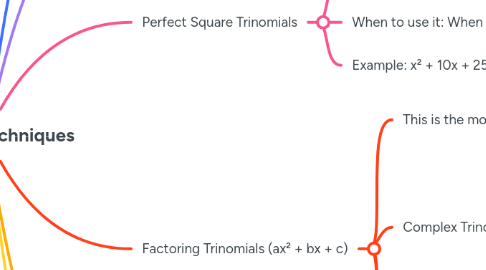Factoring Techniques
ABDULRAHMAN MAHDIにより


1. Greatest Common Factor (GCF)
1.1. What it is: Finding the largest factor that divides evenly into all terms of an expression.
1.2. When to use it: Always check for a GCF first! It simplifies the expression before applying other methods.
1.3. Example: 6x² + 9x = 3x(2x + 3) (Here, 3x is the GCF)
2. Difference of Squares
2.1. What it is: Factoring an expression in the form a² - b² into (a + b)(a - b).
2.2. When to use it: When you have two perfect squares separated by a subtraction sign.
2.3. Example: x² - 16 = (x + 4)(x - 4)
3. Perfect Square Trinomials
3.1. What it is: Factoring expressions in the form a² + 2ab + b² into (a + b)² or a² - 2ab + b² into (a - b)².
3.2. When to use it: When you have a trinomial (three terms) where the first and last terms are perfect squares, and the middle term is twice the product of their square roots.
3.3. Example: x² + 10x + 25 = (x + 5)²
4. Factoring Trinomials (ax² + bx + c)
4.1. This is the most general case and has a couple of variations:
4.1.1. Simple Trinomials (a = 1):
4.1.1.1. What to do: Find two numbers that multiply to 'c' and add up to 'b'.
4.1.1.1.1. Example: x² + 7x + 12 = (x + 3)(x + 4) (3 * 4 = 12, and 3 + 4 = 7)
4.2. Complex Trinomials (a ≠ 1):
4.2.1. What to do: Several methods exist, including:
4.2.1.1. Factoring by Grouping: Rewrite the middle term (bx) as the sum of two terms whose product is equal to ac. Then factor by grouping.
4.2.1.1.1. Example: 2x² + 5x + 2
